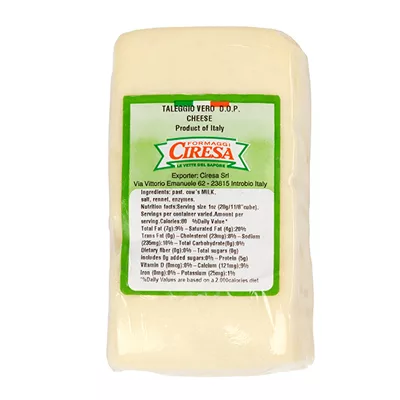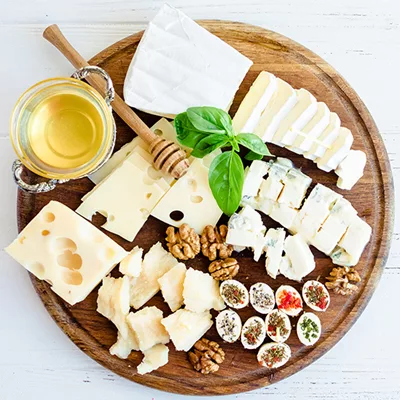
ALL ABOUT ITALIAN CHEESE
ITALIAN CHEESE
We’re pretty sure that when the jingle writers turned the opening song to “Oliver” into “Cheese, Glorious Cheese” – they were actually talking about Italian cheese. Americans consume more Italian-style cheeses than other types, and it tops some of our favorite foods, including Mozzarella for pizza and Parmigiano-Reggiano for pasta. Gelson’s sells more than a dozen varieties of Italian-produced or Italian-style cheeses.
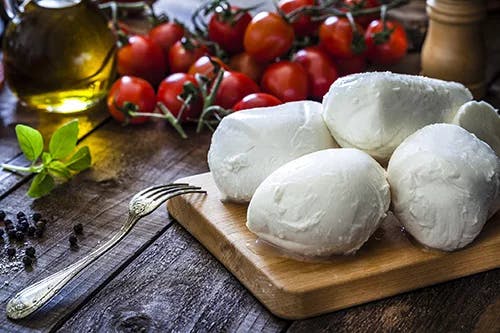
History and Origin
Italian cheese-making dates back thousands of years, where we know from ancient historical records and literature that the breeding of sheep and goats and the preparation of cheeses made from their milk was well-developed for at least 2,000 years. Cheese was valued both in the imperial palaces of Roman rulers, where the sheep’s milk Pecorino Romano was prized; as well as for more utilitarian varieties which traveled well, for use when the Roman legions marched into distant territories.
Cheese-making really took off in the Middle Ages, when monasteries across modern-day Italy were centers for creating cheese and passing down the recipes throughout generations.
Today, Italy’s proud cheese-making traditions are regulated and codified to be sure that customers can expect consistent product. Cheeses which feature a “Protected Designation of Origin” (PDO) are produced, processed and prepared in a specific geographical area. While there are many cheeses that are “Italian-Style” which are also excellent, try a “PDO” cheese to taste an authentic recipe.
How the Cheese is Made
Gelson’s carries dozens of Italian or Italian-inspired cheeses. Please read below for the cheese-making process for each variety along with recipe tips and more.
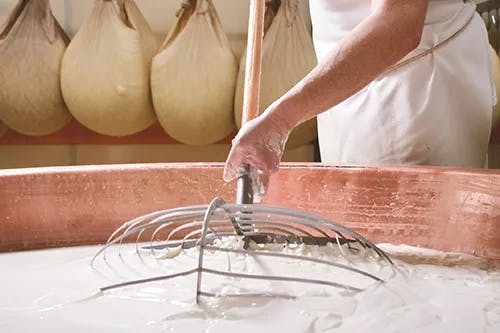
Uses
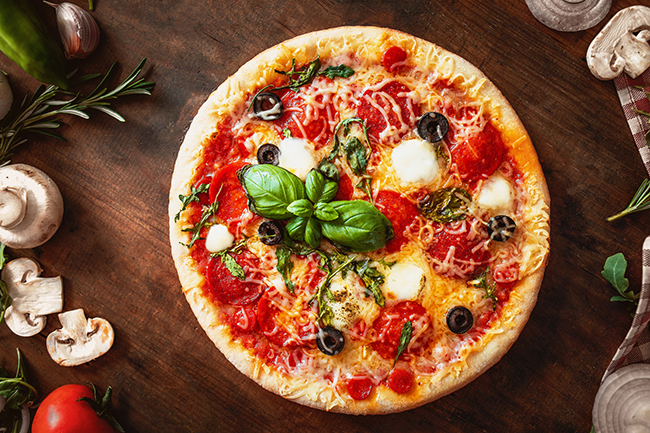
- Asiago – a cow’s milk cheese that melts in your mouth, releasing both sweet and sightly sour notes as a young cheese. When aged, Asiago is a strong and flavorful cheese. Fresh Asiago is made from whole cow’s milk with a pale yellow or white color with a thin rind and small holes throughout with a medium texture, while Aged Asiago is made from whole and skim milk, and ranges from amber yellow to pale yellow and is firmer and nuttier-tasting. Asiago can be made in other countries but will not have the DOP or PDO emblem. Try Fresh Asiago sliced on crackers, melted on pizza, or added into a cheesy pasta dish. Aged Asiago is excellent when grated or shaved on top of soups, salads, vegetables, pasta, and sauces.
- Boschetto al Tartufo is a specialty cheese made by the agricultural cooperative Il Forteto based in Tuscany and belonging to the Pecorino Toscano DOP Consortium. This tender cheese is made from a combination of cow’s and sheep’s milk and features shavings of white truffles throughout. It can be gently grated to melt over pizza, pasta, eggs – or the world’s best mac ‘n’ cheese.
- Burrata (typically located in Gelson’s deli case, rather than the specialty cheese case). Creamy and milky with a luxurious mouthfeel, Burrata is made from cream, mozzarella, with a center of stracciatella (shredded mozzarella mixed with cream); it is encased in the leaves of a lily plant and brined (traditionally) but it is now typically knotted up with string and brined in a plastic wrapper. Don’t worry, though – burrata is not salty, and brining simply refers to the lactic acid bath in which it finishes. Burrata is traditionally made with buffalo milk. Richer-tasting than mozzarella, this cream-infused cheese is added to bruschetta, salads or occasionally to pizza.
- Fontina – a semi-soft cheese with bubbly holes, creamy in flavor, and aged, nutty notes, this is a fantastic cheese for melting. Cow’s milk is heated, strained, salted, and poured into molds to age for as little as 3 months, and as long as 10 months. Fontina can be made into a killer fondue base and is great in quiche.
- Gorgonzola – described in our Blue Cheese section.
- Grana Padano (American Grana): Its grainy structure gives the cheese its name (“Grana”) – a hard, cooked, semi-fat and slowly aged cow’s milk cheese. This cheese is milder than Parmesan, but still has a savory, slightly salty flavor. Grana Padano is made entirely from skim milk, unlike Parmigiano Reggiano, and only needs to age for a minimum of 9 months. Grana Padano is fantastic when shaved over a fresh Pasta Bolognese or used in eggplant or chicken Parmesan.
- La Tur (merchandised in the soft cheese/Brie section of the Gelson’s specialty cheese case) is a blend of cow, goat, and sheep’s milk and is incredibly decadent, rich, and creamy – nearly runny – in the middle. The soft outer rind can be eaten and is best spread on crackers, but this cheese is a bit funkier than brie thanks to the goat’s milk. The Piedmont region of northwest Italy is home to this soft cheese, an area also known for its sparkling wines, which pair beautifully with La Tur.
- Mozzarella, Fresh (predominately located in Gelson’s deli case, rather than the specialty cheese section) – a fresh cheese made from cow’s milk rather than that of water buffalo. It is a soft, rindless, smooth, shiny and milky white cheese. Traditionally used for Caprese salad and Margherita pizza, the cheese is sold in many shapes. Bocconcini and Ovolini are round balls kept in liquid in a tub (best in salads), while firm blocks of mozzarella can be sold packaged, or shredded to be easily incorporated into recipes (best in pizza or other recipes where you do not want a runny liquid).
- Mozzarella di Bufala (located in Gelson’s deli case rather than the specialty cheese section) – made from the milk of water buffalos, similar to cow’s milk mozzarella but creamier. Also traditionally used for Caprese salad and Margherita pizza.
- Parmigiano Reggiano + Parmesan – the “King” of Italian cheese, it is a cooked and non-pressed cheese which matures for at least 12 months, but only approaches peak flavor when it has aged for at least 24 months – with some aged up to 6 years. Legally, Parmigiano Reggiano is made from the whole and skimmed milk of grass-fed cows between April and November. A hard cheese sold in wedges, shredded, or shaved, Parmigiano Reggiano (or Parmesan which does not have the same regulations) is often served over fresh pasta, imparting its delicious umami taste to dishes.
- Pecorino Romano – A hard sheep’s milk cheese that is nutty, tangy, and salty. There are six main regional variants of Pecorino, with Pecorino Romano being the best known. Many recipes will call for a mix of Pecorino Romano with other cheeses, such as our Cacio e Pepe recipe, but it stands beautifully alone especially when used to top recipes made with springy vegetables – try our Edamame & Pea Toast or Spring Vegetable Salad with Poached Egg recipes.
- Provolone – A semi-hard cheese made from aged, stretched-curds of cow’s milk, provolone can be aged from as little as four months (“provolone dolce”) to as long as three years (“provolone picante”). Provolone is an excellent melting cheese, perfect for use in tarts, quiche, diced in salads, or even to elevate a grilled cheese sandwich.
- Toma – Gelson’s sells Point Reyes Toma, which is an excellent American take on a traditional Italian table cheese. This semi-hard cheese is all natural, pasteurized rBST-free cow’s milk, with a waxed rind. The creamy, buttery flavor and grassy finish make Toma an excellent choice for melting into risotto or pasta and grated on top of or melted into fresh vegetables or soups. Try it with Brussels Sprouts!
Sources
- “The Most Popular Cheeses in the World” Retrieved May 5, 2022.
- Italian Made Cheese History Retrieved May 9, 2022.
- Il Forteto (translated into English) Retrieved May 10, 2022.
- La Tur Cheese Retrieved May 10, 2022.
- Toma Retrieved May 10, 2022.
- Alfaro, Danilo. (2019). “Asiago Cheese” Retrieved May 10, 2022.
- Plumbaum, Anna. “The Complete Guide to Italian Cheeses (and the 13 Kinds to Know)” Retrieved May 10, 2022

